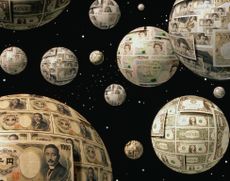When will the US stockmarket bubble burst?
With US stocks more expensive than before the Wall Street crash of 1929, there are growing signs of “mania”. But what will push markets over the edge?

Is the US stockmarket in “one of the great bubbles of financial history”? That is the opinion of Jeremy Grantham of asset manager GMO, who sees signs of mania everywhere from Tesla’s soaring share price to the surge in “blank cheque” companies, or special purpose acquisition companies (SPACs), says Jack Hough in Barron’s.
The Great Crash of 2021?
US stocks are more expensive than they were prior to the Wall Street crash of 1929 on a cyclically adjusted price/earnings (Cape) basis. Paradoxically, Grantham thinks that it could be good news this year that ultimately does for the bull market.
“The market doesn’t end with some terrible burst of bad news... It ends when things are pretty darn good, but not quite as good as yesterday.” Relief that Covid-19 is finally ebbing thanks to vaccines could give way to the gloomy realisation that the economy is in a bad way.
Subscribe to MoneyWeek
Subscribe to MoneyWeek today and get your first six magazine issues absolutely FREE

Sign up to Money Morning
Don't miss the latest investment and personal finances news, market analysis, plus money-saving tips with our free twice-daily newsletter
Don't miss the latest investment and personal finances news, market analysis, plus money-saving tips with our free twice-daily newsletter
It is becoming difficult to resist parallels with the dotcom bubble, which burst in spectacular fashion in the year 2000, says Michael Mackenzie in the Financial Times. The technology-focused Nasdaq index has notched up annual gains of around 40% for two years running. Yet this market is split in two. The money surging into the likes of Tesla and bitcoin does look like dotcom-style speculation, but the established tech giants – such as Amazon, Facebook and Google – boast solid earnings. Indeed, so reliable are the profits of big tech that this select club is now often compared to safe-haven assets such as bonds.
“It is easy to spot bubbles,” says James Mackintosh in The Wall Street Journal. The tricky part is predicting when they will end. In 2017 fund manager Paul McNamara constructed a “bubble portfolio” made up of all the assets then widely considered the most overvalued. It included Tesla, Netflix, US bonds and London property.
Many of these assets did subsequently dip, but then came roaring back last year. The portfolio has now more than tripled since mid-2017. Before they pop, “bubbles can always become more extreme”.
Rational exuberance?
There are growing signs of “mania” in the marketplace, but this could only be the beginning of the end, says Eoin Treacy on fullertreacymoney.com. With interest rates and bond yields so low there is still plenty of money available to leap into speculative assets.
While shares in the US and elsewhere look expensive compared with their underlying earnings, they don’t look quite so dear when compared to government bond yields, which are trading at historic lows (and are below zero in many parts of Europe).
With bonds paying so little, yield-starved investors are being forced to put cash into equities. The Biden administration’s plans for a new $1.9trn stimulus package will only add more fiscal fuel to the fire. High valuations follow logically from historically loose monetary policy, says Capital Economics. Most investors think interest rates will stay nailed to the floor over the next few years, which should mean equity valuations stay high. Indeed, rising earnings forecasts mean that valuations across developed markets have actually fallen back slightly in recent months.
UK shares: the safer option
British shares have finally joined the stockmarket party, says Patrick Hosking in The Times. The FTSE 100 enjoyed its best ever start to the year earlier this month and is up by almost 4% so far in 2021. That easily beats America’s S&P 500, which has gained less than 0.5% so far. The British blue-chip index has risen by 20% since the start of November. There may be frenzy on Wall Street, but the climate in the City remains more cautious. Many British fund managers are best described as “reluctant bulls”.
All this talk of a bubble sounds strange to British ears, as Simon Nixon points out in the same paper. The FTSE remains well short of its pre-pandemic levels despite recent gains and is currently trading on a Cape ratio of about 13.7, making it far cheaper than most other developed markets. By contrast, with the S&P 500 on a Cape of about 34 there could be a long way down for US shares.
-
 Rightmove: Asking prices edge closer to record peak
Rightmove: Asking prices edge closer to record peakAsking prices have been driven up by the top-end of the market, Rightmove has found. But how does the situation look in your area?
By Vaishali Varu Published
-
 Coventry Building Society bids £780m for Co-operative Bank - what could it mean for customers?
Coventry Building Society bids £780m for Co-operative Bank - what could it mean for customers?Coventry Building Society has put in an offer of £780 million to buy Co-operative Bank. When will the potential deal happen and what could it mean for customers?
By Vaishali Varu Published
-
 The industry at the heart of global technology
The industry at the heart of global technologyThe semiconductor industry powers key trends such as artificial intelligence, says Rupert Hargreaves
By Rupert Hargreaves Published
-
 Three emerging Asian markets to invest in
Three emerging Asian markets to invest inProfessional investor Chetan Sehgal of Templeton Emerging Markets Investment Trust tells us where he’d put his money
By Chetan Sehgal Published
-
 What to consider before investing in small-cap indexes
What to consider before investing in small-cap indexesSmall-cap index trackers show why your choice of benchmark can make a large difference to long-term returns
By Cris Sholto Heaton Published
-
 Why space investments are the way to go for investors
Why space investments are the way to go for investorsSpace investments will change our world beyond recognition, UK investors should take note
By Merryn Somerset Webb Published
-
 Time to tap into Africa’s mobile money boom
Time to tap into Africa’s mobile money boomFavourable demographics have put Africa on the path to growth when it comes to mobile money and digital banking
By Rupert Hargreaves Published
-
 M&S is back in fashion: but how long can this success last?
M&S is back in fashion: but how long can this success last?M&S has exceeded expectations in the past few years, but can it keep up the momentum?
By Rupert Hargreaves Published
-
 The end of China’s boom
The end of China’s boomLike the US, China too got fat on fake money. Now, China's doom is not far away.
By Bill Bonner Published
-
 Magic mushrooms — an investment boom or doom?
Magic mushrooms — an investment boom or doom?Investing in these promising medical developments might see you embark on the trip of a lifetime.
By Bruce Packard Published